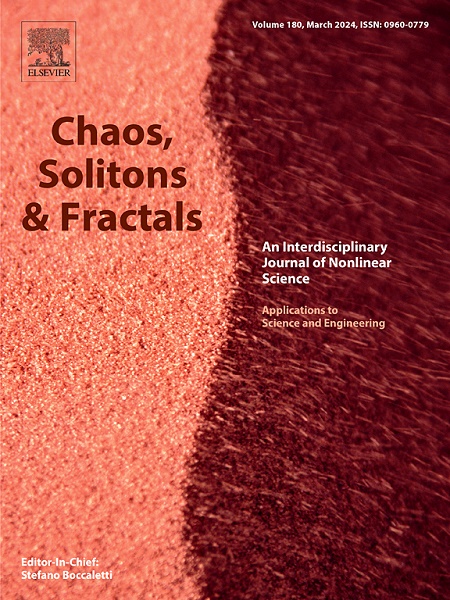Driven transitions between megastable quantized orbits
IF 5.3
1区 数学
Q1 MATHEMATICS, INTERDISCIPLINARY APPLICATIONS
引用次数: 0
Abstract
We consider a nonlinear oscillator with state-dependent time-delay that displays a countably infinite number of nested limit cycle attractors, i.e. megastability. In the low-memory regime, the equation reduces to a self-excited nonlinear oscillator and we use averaging methods to analytically show quasilinear increasing amplitude of the megastable spectrum of quantized quasicircular orbits. We further assign a mechanical energy to each orbit using the Lyapunov energy function and obtain a quadratically increasing energy spectrum and (almost) constant frequency spectrum. We demonstrate transitions between different quantized orbits, i.e. different energy levels, by subjecting the system to an external finite-time harmonic driving. In the absence of external driving force, the oscillator asymptotes towards one of the megastable quantized orbits having a fixed average energy. For a large driving amplitude with frequency close to the limit cycle frequency, resonance drives transitions to higher energy levels. Alternatively, for large driving amplitude with frequency slightly detuned from limit-cycle frequency, beating effects can lead to transitions to lower energy levels. Such driven transitions between quantized orbits form a classical analog of quantum jumps. For excitations to higher energy levels, we show amplitude locking where nearby values of driving amplitudes result in the same response amplitude, i.e. the same final higher energy level. We rationalize this effect based on the basins of different limit cycles in phase space. From a practical viewpoint, our work might find applications in physical and engineering system where controlled transitions between several limit cycles of a multistable dynamical system is desired.
超稳态量子化轨道之间的驱动跃迁
我们考虑一个具有状态相关时滞的非线性振荡器,它具有无数个嵌套的极限环吸引子,即超稳态。在低记忆状态下,将方程简化为自激非线性振荡器,并利用平均方法解析出量子化准圆轨道的超稳态谱的拟线性增长幅度。我们进一步使用Lyapunov能量函数为每个轨道分配机械能,并获得二次增加的能谱和(几乎)恒定的频谱。我们演示了不同量子化轨道之间的跃迁,即不同的能级,通过使系统受到外部有限时间谐波驱动。在没有外力的情况下,振子渐近线向具有固定平均能量的超稳态量子化轨道之一移动。当驱动幅值较大且频率接近极限环频率时,谐振驱动会过渡到更高的能级。或者,对于频率稍微偏离极限环频率的大驱动振幅,跳动效应可以导致向较低能级的过渡。这种在量子化轨道之间的驱动跃迁形成了量子跃迁的经典模拟。对于更高能级的激励,我们显示了振幅锁定,其中附近的驱动振幅值导致相同的响应振幅,即相同的最终更高能级。我们基于相空间中不同极限环的盆地来合理化这种效应。从实际的角度来看,我们的工作可能会在物理和工程系统中找到应用,其中需要在多稳定动力系统的几个极限环之间进行控制转换。
本文章由计算机程序翻译,如有差异,请以英文原文为准。
求助全文
约1分钟内获得全文
求助全文
来源期刊

Chaos Solitons & Fractals
物理-数学跨学科应用
CiteScore
13.20
自引率
10.30%
发文量
1087
审稿时长
9 months
期刊介绍:
Chaos, Solitons & Fractals strives to establish itself as a premier journal in the interdisciplinary realm of Nonlinear Science, Non-equilibrium, and Complex Phenomena. It welcomes submissions covering a broad spectrum of topics within this field, including dynamics, non-equilibrium processes in physics, chemistry, and geophysics, complex matter and networks, mathematical models, computational biology, applications to quantum and mesoscopic phenomena, fluctuations and random processes, self-organization, and social phenomena.
 求助内容:
求助内容: 应助结果提醒方式:
应助结果提醒方式:


